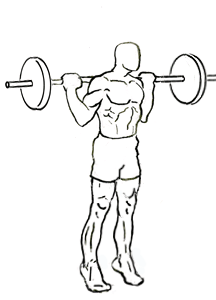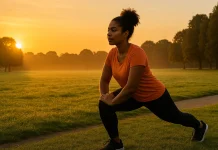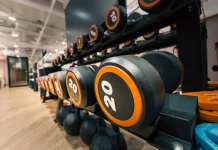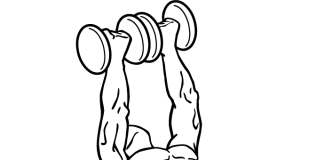Last Updated on September 26, 2014
The Rocking Standing Calf Raise with Barbell is an effective yet simple exercise targeting the calf muscles, with the added benefit of engaging your balance and stability. Utilizing a unique “rocking” motion, this exercise helps strengthen not only the gastrocnemius and soleus (key muscles of the calf) but also improves ankle mobility and stability. In this guide, we’ll cover how to perform the exercise correctly, the benefits it brings to your workout routine, tips to avoid common mistakes, variations for added intensity, and much more.
What Are the Benefits of the Rocking Standing Calf Raise with Barbell?
- Calf Strengthening: This exercise focuses on building the gastrocnemius and soleus muscles, which are critical for daily movements, such as walking, running, and jumping.
- Improves Balance and Stability: The rocking motion forces your core and stabilizers to engage, promoting balance.
- Ankle Flexibility and Mobility: Rocking back onto your heels stretches the ankle joint, enhancing flexibility, which is beneficial for athletes and those looking to improve lower leg mobility.
- Functional Strength: Because it involves a controlled, weight-bearing movement, it develops functional strength that applies directly to sports and activities that require calf engagement and stability.
Equipment Needed
- Barbell (start light if you’re new to the movement)
- Comfortable, stable running or cross-training shoes
- Optional: Calf block or step for an extended range of motion
Muscles Targeted The Rocking Standing Calf Raise with Barbell targets:
- Gastrocnemius (primary calf muscle)
- Soleus (deep calf muscle)
- Tibialis anterior (front of the shin)
- Stabilizer muscles in the core and ankles
How to Perform the Rocking Standing Calf Raise with Barbell: Step-by-Step Guide
- Setup: Begin by positioning a barbell across your shoulders, similar to a squat position. Keep your feet flat on the floor, spaced about hip-width apart for stability. Stand up straight with a slight bend in the knees to avoid locking them.
- Engage Your Core: Brace your core, keep your chest up, and gaze forward. This posture will help you maintain stability throughout the movement.
- Raise Onto the Balls of Your Feet: With a controlled movement, rise onto the balls of your feet as if performing a standard calf raise. Focus on squeezing the calf muscles at the top for maximum engagement.
- Rock Back onto Heels: Once you reach the top of the calf raise, begin shifting your weight backward, lowering onto your heels so that your toes lift off the ground. This part of the movement engages the tibialis anterior, helping to balance out the work done by the calves.
- Return to Start Position: Complete the “rocking” motion by returning your feet flat to the ground, regaining balance and stability before performing the next repetition.
Tips for Proper Form
- Avoid Excessive Swaying: Move in a controlled, deliberate motion, resisting the urge to sway too quickly. Speed may compromise the benefits and increase injury risk.
- Focus on Mind-Muscle Connection: During the calf raise portion, consciously squeeze the calf muscles, and during the rock-back, focus on the tibialis anterior.
- Breathe Naturally: Inhale before the lift and exhale during the rocking motion to avoid holding your breath, which can destabilize the core.
Common Mistakes to Avoid
- Using Too Much Weight: Begin with a manageable weight. Excessive weight can lead to instability and make it challenging to perform the full rocking motion.
- Improper Footwear: Running or cross-training shoes with good ankle support are essential to prevent slipping and maintain balance.
- Rushing Through the Movement: Each part of the rocking calf raise requires control. Rushing can lead to ineffective muscle engagement and increase the chance of injury.
- Leaning Forward: Avoid leaning too far forward during the calf raise. Keep your body upright to engage the calves properly.
Variations of the Rocking Standing Calf Raise To keep things challenging and add variety to your routine, consider these variations:
- Rocking Calf Raise with Dumbbells: If you’re uncomfortable with a barbell, holding dumbbells at your sides can offer similar benefits.
- Single-Leg Rocking Calf Raise: Perform the exercise on one leg at a time, enhancing stability and muscle activation.
- Seated Rocking Calf Raise: For a more isolated approach, perform the exercise seated, rocking your feet up and down to focus solely on the calves.
- Calf Raise on a Block: Use a raised surface, like a calf block, for a greater range of motion, maximizing stretch and contraction of the calves.
How to Incorporate the Rocking Standing Calf Raise into Your Workout The Rocking Standing Calf Raise is a valuable addition to any lower body routine. Here are a few ways to incorporate it:
- Lower Body Day: Add it as a finishing move after squats, lunges, and deadlifts to target the calves and tibialis anterior.
- Calf Focused Workout: Pair it with other calf exercises, like seated calf raises or donkey calf raises, for a dedicated calf workout.
- Core Routine: Since it engages stabilizers, include it in a core-focused workout for added balance work.
Reps and Sets To maximize the effectiveness, aim for:
- Beginners: 3 sets of 10-12 reps, focusing on control.
- Intermediate to Advanced: 4 sets of 15-20 reps, adding weight as you become comfortable with the movement.
Safety Considerations
- Warm Up Thoroughly: Cold muscles are more prone to strain. Perform a dynamic warm-up before starting.
- Start with Body Weight: Practice the movement without any weights to familiarize yourself with the rocking motion.
- Check Your Footwear: Shoes with proper arch support can help with balance and prevent slipping.
Frequently Asked Questions
- Can I perform this exercise without weights? Yes, starting with body weight helps you learn the rocking motion safely and build strength gradually.
- What muscles are primarily engaged during this exercise? The gastrocnemius, soleus, and tibialis anterior are the main muscles targeted, along with core and ankle stabilizers.
- How often should I perform calf exercises for growth? For strength and growth, aim to work your calves two to three times per week, allowing recovery between sessions.
- Why is ankle flexibility important? Strong, flexible ankles can improve athletic performance, reduce injury risk, and support functional movements.
Conclusion The Rocking Standing Calf Raise with Barbell is an excellent exercise for building not only calf strength but also balance and ankle stability. With its unique rocking motion, this exercise targets muscles often overlooked in standard calf raises, making it an ideal addition to a well-rounded workout. Remember, mastering the form is key, so take your time and increase the weight only as you feel comfortable. With consistency and proper technique, you’ll see noticeable improvements in calf strength, ankle mobility, and overall stability.
Ready to add the Rocking Standing Calf Raise to your workout? Start with light weights, focus on control, and enjoy the benefits of a simple yet effective movement that will have you feeling stronger with each rep.








